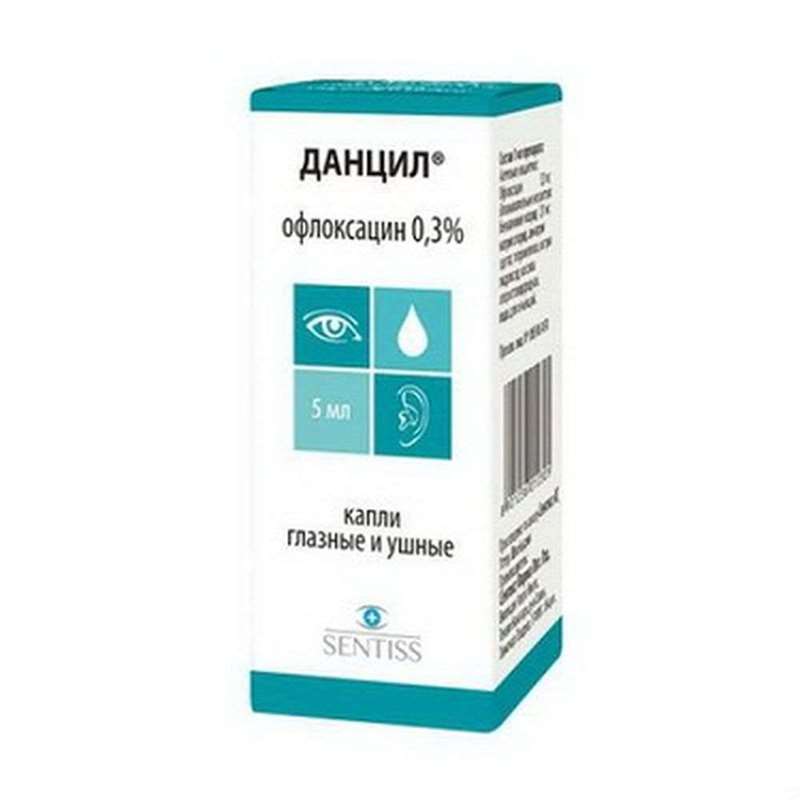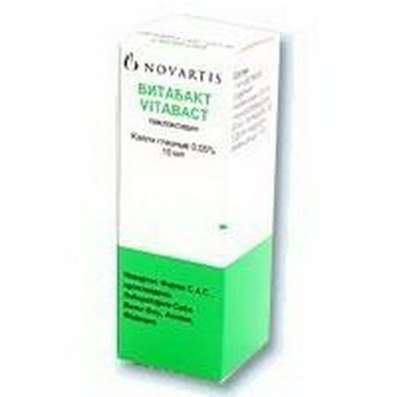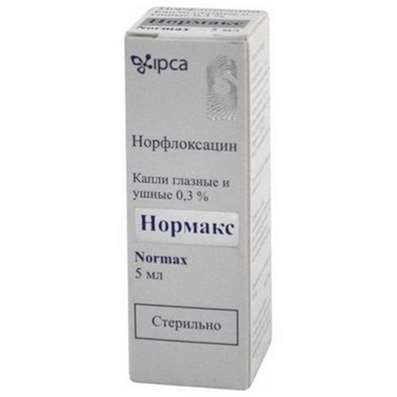Dancil - is an eye drop that has an antimicrobial effect. Apply it to infectious diseases of the optical apparatus, as well as to prevent infection in operations or injuries.
The drug Dancil belongs to the group of antimicrobial antibiotics of fluoroquinolones. The mechanism of its action is associated with an effect on the enzyme called DNA-gyrase, which normally ensures the stability of the DNA of the pathogen by means of supercoiling. As a result of destabilization of the genetic material of bacteria, their death occurs, that is, the medicine has a bactericidal effect.
Ofloxacin is not sensitive to the action of certain enzymes released by bacteria. These include beta-lactamases, adenylases, acetyltransferases, phosphorylases.
Ofloxacin is a synthetic preparation that is a fluorinated quinolone. It has a wide spectrum of action and is effective against gram-negative microorganisms. On Gram-positive bacteria it acts to a lesser extent.
Antimicrobial agent of the group of fluoroquinolones of wide spectrum of action. The bactericidal effect of ofloxacin is associated with the blockade of the DNA-gyrase enzyme in bacterial cells.
Highly active against most Gram-negative bacteria: Escherichia coli, Salmonella spp., Shigella spp., Proteus spp., Morganella morganii, Klebsiella spp. (including Klebsiella pneumoniae), Enterobacter spp., Serratia spp., Citrobacter spp., Yersinia spp., Providencia spp., Haemophilus influenzae, Neisseria gonorrhoeae, Neisseria meningitidis, Mycoplasma spp., Legionella pneumophila, Acinetobacter spp., as well as Chlamydia spp.
It is active against some Gram-positive microorganisms (including Staphylococcus spp., Streptococcus spp. / Especially beta-hemolytic streptococci /).
To ofloxacin moderately sensitive Enterococcus faecalis, Streptococcus pneumoniae, Pseudomonas spp.
Ofloxacin is not sensitive to anaerobic bacteria (except Bacteroides ureolyticus).
Resistant to the action of β-lactamases.
Pharmacokinetics
After ingestion quickly and completely absorbed from the digestive tract. Eating slightly affects the degree of absorption, but it can slow down its speed. Cmax in blood plasma is achieved after 2 hours.
Binding to proteins - 25%. Ofloxacin widely distributed in tissues and body fluids (organs of the urinary system, genitals, prostate, lungs, ENT organs, gall bladder, bones, skin).
It is excreted unchanged in urine (about 80% in 24 hours). The concentration of ofloxacin in urine was significantly higher than the MIC90 for most microorganisms after the last dose (300 mg twice per day for 14 days). A small part of the active substance (about 4%) is excreted with feces. T1 / 2 is 6 hours. In elderly patients with CK, an average of 50 ml / min may increase T1 / 2 to 13.3 hours.
Indications:
Infectious and inflammatory diseases caused by microorganisms sensitive to ofloxacin, including: diseases of the lower respiratory tract, ear, throat, nose, skin, soft tissues, bones, joints, infectious and inflammatory diseases of the abdominal cavity (with the exception of bacterial enteritis ) and small pelvis, infection of the kidneys and urinary tract, prostatitis, gonorrhea.
Contraindications:
Pregnancy, lactation, children and adolescents under 18, hypersensitivity to ofloxacin or other quinolone derivatives.
Special instructions:
Use with caution in patients with impaired renal and hepatic function.
During the period of treatment, it is required to monitor blood glucose levels. With prolonged therapy, it is necessary to periodically monitor the functions of the kidneys, liver, and the picture of peripheral blood.
When using ofloxacin should provide sufficient hydration of the body, the patient should not be exposed to ultraviolet radiation.
In experimental studies, a mutagenic potential was not detected. Long-term studies to determine the carcinogenicity of ofloxacin were not performed.
In studies on young animals of several species ofloxacin caused arthropathy and osteochondrosis.
Safety and efficacy in children and adolescents under the age of 18 years have not been established.
Impact on the ability to drive vehicles and manage mechanisms
Use with caution in patients whose activities are associated with the need for high concentration of attention and speed of psychomotor reactions.
Suggested Use:
Infectious Diseases of the Eyes
Treatment of bacterial ulcers of the cornea. The recommended dose of ofloxacin for adults and children aged 1 year and older is 1-2 drops of 0.3% solution in the affected eye (or both eyes) every 30 minutes during wakefulness, then 4 and 6 hours after falling asleep, during 2 days. Starting from the 3rd day of treatment and during the next 4-6 days, the solution can be instilled in 1-2 drops every hour during waking period, then 1-2 drops 4 times a day for another 3 days or until the clinical cure.
Treatment of conjunctivitis, blepharitis, keratoconjunctivitis, keratitis, meibomitis, dacryocystitis and prevention of infections in ophthalmic surgery after eye trauma and surgical interventions. Ofloxacin in the form of eye drops is usually used only during the waking period. For adults and children aged 1 year and older, the recommended dose of ofloxacin is 1-2 drops of 0.3% solution in the affected eye (or both eyes) every 2-4 hours (during wakefulness) for 2 days, then 1- 2 drops 4 times a day for no more than 5 days.
Ear infections
Adults and children over 12 years of age
External otitis - 10 drops per affected ear once a day for 10 days.
Chronic suppurative otitis media with chronic perforation of the tympanic membrane - 10 drops per affected ear twice a day for 14 days.
Otitis with an established tympanostomy tube - 5 drops in the affected ear 2 times a day for 10 days.
Children from 1 to 11 years old
The doctor should specifically prescribe the use of the drug and determine the dosage. All treatment should be carried out under his outpatient supervision.
Treatment of external otitis and acute otitis media with an established tympanostomy tube. The recommended dose is 5 drops per affected ear 3 times a day for 10 days.
Before instillation, you should warm the bottle in your hand for 1-2 minutes to avoid the development of dizziness (possibly when using a cold solution). The instillation is performed in the patient's position lying on its side. After instillation, the patient should maintain this position for 5 minutes to facilitate passage of the solution through the external auditory meatus. If necessary, instillation in the other ear works in a similar way.
Packaging:
- Comes in original packaging. Item is brand new and unopened.
Storage:
- Keep away from direct sunlight.
- Keep locked and away from children.
- Store in dry place at room temperature.
- Do not exceed storage temperature higher than 25 C
Important notice- the outer box design may vary before prior notice!

 Cart
Cart





